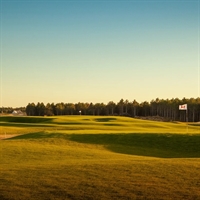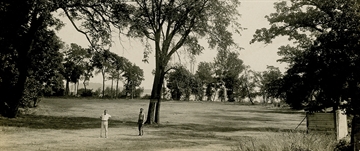2024 High School Prep Preview
March 15, 2024
Long ago, a fearsome giant occupied the sandy coastline of present-day Long Island, and then went extinct.
Only to be brought back to life. In central Wisconsin.
No, this isn’t some kind of Jurassic Park science fiction tale. This is the true resurrection story of The Lido, perhaps the best golf course ever designed by the legendary Charles Blair Macdonald, creator of The National Golf Links of America and a dozen other trailblazing courses a century ago. When The Lido opened on Long Island in 1917, it was considered one of the best—and most difficult—golf courses in the world. The Great Depression and World War II combined to put an end to The Lido’s brief but glorious supremacy (it was plowed under by the U.S. Navy in the early 1940s), but golf historians have never let the course become forgotten.
One such amateur historian, Peter Flory of Chicago, became so consumed with curiosity about The Lido that he began studying the course until he was able to create a remarkably accurate computer model of its entire 18 holes. Coincidentally, brothers Mike and Chris Keiser—the sons of Mike Keiser, Sr., creator and developer of the Bandon Dunes and Sand Valley golf resorts—had been considering the idea of recreating The Lido for some time, dating back to the building of Bandon Dunes on the Oregon coast in the late 1990s.
Recreating a Masterpiece
In 2019, the financial wherewithal and creative desire of the Keisers met with the computer expertise and historical knowledge of Flory. Armed with Flory’s model, the Keisers hired top-shelf golf course architect Tom Doak to build an exact replica of The Lido on a dead-flat 225-acre parcel of land across the road from Sand Valley, located 20 miles south of Wisconsin Rapids. The new Lido will open as a private course, with limited access for Sand Valley resort customers, in the spring of 2023.
Flory, a financial consultant in real life, began dabbling with golf-course design programs while in junior high school. He began his Lido model during a time when his consulting work was slowing down after a busy decade.
“I was looking for a creative outlet at the end of that,” Flory says. “When we built our house [in Chicago], we put a golf simulator in the basement. That renewed my interest in digital golf design, by building courses that my kids could play. I got thinking of the lost course concept, and how the digital construction of these course simulators could be used to play courses that were no longer existing. I decided to tackle the holy grail of lost golf, and that was the Lido course.”
He looked up all the information that fellow golf buffs had posted on Golf Club Atlas, the website devoted to the study of golf courses and golf architecture, and read every book that dealt with The Lido.
“The goal was to build it on my basement simulator, to be the first person to understand what it was and play it again,” Flory says. “It was easy to get it in two dimensions because of old aerials. I basically sketched out the course digitally.”
He began with the 8th hole—the original Biarritz hole on the ocean, modeled by Macdonald after a hole in France that became an oft-repeated template on most of his courses, with a deep swale running either in front of or through the middle of the green.
“I would post my progress on Golf Club Atlas,” Flory says. “Just on that one hole, the response was heavy. All of a sudden I had a lot of people commenting on it: ‘I think you’re misinterpreting this angle; this should be this…’ I found the process very helpful.”
He visited historical societies and archives to locate original, high-definition photos of the course, and his peers sent him photos and information, including a set of stereo images of the Lido—consecutive aerials taken on the same military survey flight some 400 yards apart. With one image color-coded red and the other blue, transparently overlapping the images created a 3D effect that allowed Flory to see elevation changes in much greater detail.
“It felt like an archaeological dig,” Flory says. “It was like you were dusting off the course, going through this process. There would be a photo of the course, but no one knew what hole it was. But after setting up this three-dimensional model, I could zoom around until I saw things in the background that matched. I could triangulate what the mystery hole was.”
He estimated that he was about 90 percent finished with the computer model—with the goal still just to play it on his basement simulator—when he got a call from Tom Doak.
“He was curious about the accuracy of it and my methodology,” Flory says. “I think in his mind he was just wondering if I was making this up or if it was based on information. I made him comfortable that all I was doing was compiling information. I had no interest in making up a course and calling it The Lido.”
Doak called again sometime later and said Michael Keiser, Jr., wanted to talk to him about The Lido. Mike Keiser, Sr., had explored the possibility of Doak recreating the Lido at Bandon Dunes, but they decided at the time that the Oregon site had too much character and potential for unique courses of its own, so Keiser had Doak design Old Macdonald, a tribute course featuring most of Macdonald’s favorite holes fitted onto the Bandon site’s existing topography. The Sand Valley site, on the other hand, was the perfect canvas to do a total recreation: perfectly flat and sand-based, like the Lido’s original oceanside location. Of course, there was no ocean, but the water-adjacent holes are being replicated by building a large lagoon.
In December of 2019, Flory brought his laptop to a meeting with Mike Keiser, Jr., in Madison, Wisconsin, and showed him his model and his methodology.
“By end of that conversation, he says, ‘We want to build this. Do you want to help us do it?’”
He did.

Breaking Ground
By the fall of 2020, the pine trees that originally covered the property were cleared, but before the holes could be built, Flory’s program had to be adapted to LiDAR (Light Detection and Ranging) elevation scans that would allow bulldozers to push the earth into the necessary shapes. Wisconsin Rapids resident Brian Zager, who also had experience with computer golf simulations and had created LiDAR scans for the two original Sand Valley courses, figured out a way to convert Flory’s computer program into a topographical map of The Lido, accurate to one-foot increments. The bulldozer operators, under the direction of Doak associates Brian Schneider and Brian Slawnik, were guided by GPS mapping to create precise contours.
“The most interesting part of the project was getting the topo map that Brian Zager produced from Peter Flory’s model, vs. trying to do it myself,” Doak said in an e-mail response to questions about the project. “On a new project, I spend the time while the guys are working on the first few holes walking and thinking about details for the next few, but Lido is more like a restoration: The work is all a matter of interpreting the old photos and information to make the course as accurate as possible.”
Fortunately for the Keisers, the prevailing wind at Sand Valley is similar to the original site on Long Island, and the new course could be oriented in any direction on the vast expanse of treeless land.
“[Macdonald] took the wind into account when he designed the original, so it’s just lucky that the site just happens to have wind that’s a similar magnitude and from a similar direction,” Flory says. “Because otherwise, it may have created distortions out on the course in terms of the way things played.”
“There's no question that the original Lido benefited from its oceanside location, just like every other oceanside course does,” Doak says. “But the site in Wisconsin is windy enough to provide similar conditions and similar turf. And, honestly, if I had an oceanfront location, I’d rather have the freedom to do my own thing there.”
Doak does have some freedom at the Lido, but he understands he was not hired to embellish Macdonald’s masterpiece.
“We are trying to reproduce the original course as accurately as we can,” Doak says. “I’m not trying to ‘improve’ it somehow. We did make the decision at the beginning to space the holes further apart in the interest of safety, and with that spacing came the opportunity to add back tees on several holes; but you will still be able to play tees at the exact yardage of the original course.”
Of course, there is no way most golfers are going to know how faithful Doak’s construction or Flory’s plan was to the original Lido, since it is likely that no one alive ever played it.
“As with Old Macdonald, only a small percentage of the golfers care who designed the course or why,” Doak says. “They are just there to enjoy the golf. But everyone working on this project felt strongly that if we were going to use the Lido name, it was important to get the details right.”
“I decided to tackle the holy grail of lost golf, and that was the Lido course.” —Peter Flory
Anticipated Opening
A soft, nine-hole opening is expected in mid-2022 before the course officially opens in the spring of 2023, according to Sand Valley marketing and communications manager Brandon Carter. Thirteen holes were grassed in this year, and the membership is already full. Though private, the current plan is to reserve the course for member play only on weekends, and allow Sand Valley resort guests to play late morning to midday on weekdays.
Will they be playing a Macdonald or a Doak?
“The design really isn’t mine,” Doak says. “But if the original would have been classed as Macdonald/Raynor, with Raynor having built it, then I think The Lido should be Macdonald/Doak, or Macdonald/Doak/Schneider. We've put in a lot of hours to try and get it right.”
Flory will be the best judge of just how right The Lido turns out to be. Until the course is open, he’s decided that he won’t even play the model he created for his golf simulator.
“You know, I held off playing it,” he says. “When I stepped out on the construction site in Wisconsin, everything felt so big, spacious and epic. Once I did that, I decided I’m going to wait and play the real thing because it’s going to be a disappointment playing it in my basement.”
.jpg)
March 15, 2024

February 20, 2024

February 20, 2024
Contact Us
Have a question about the Minnesota Golf Association, your MGA membership or the contents of this website? Let us help.